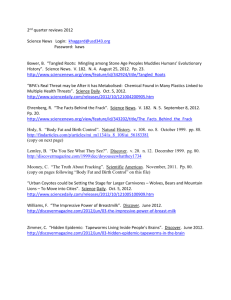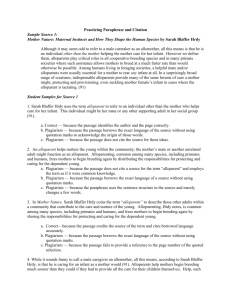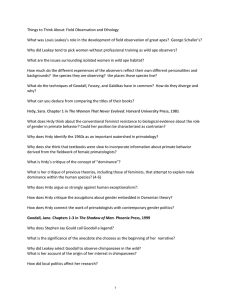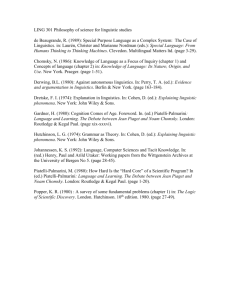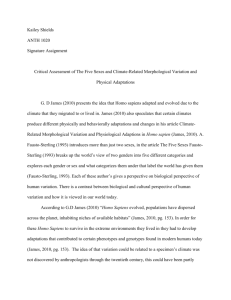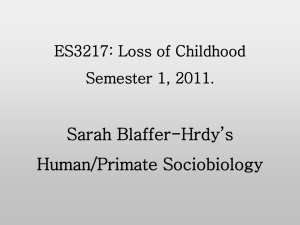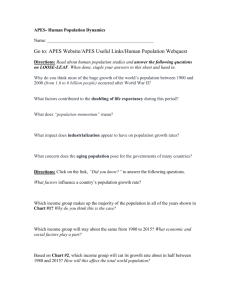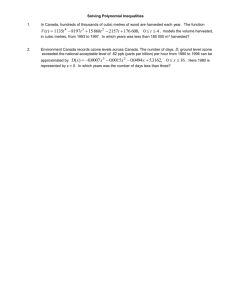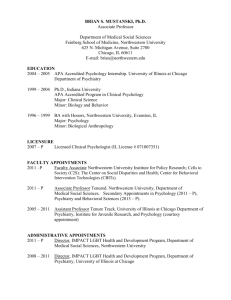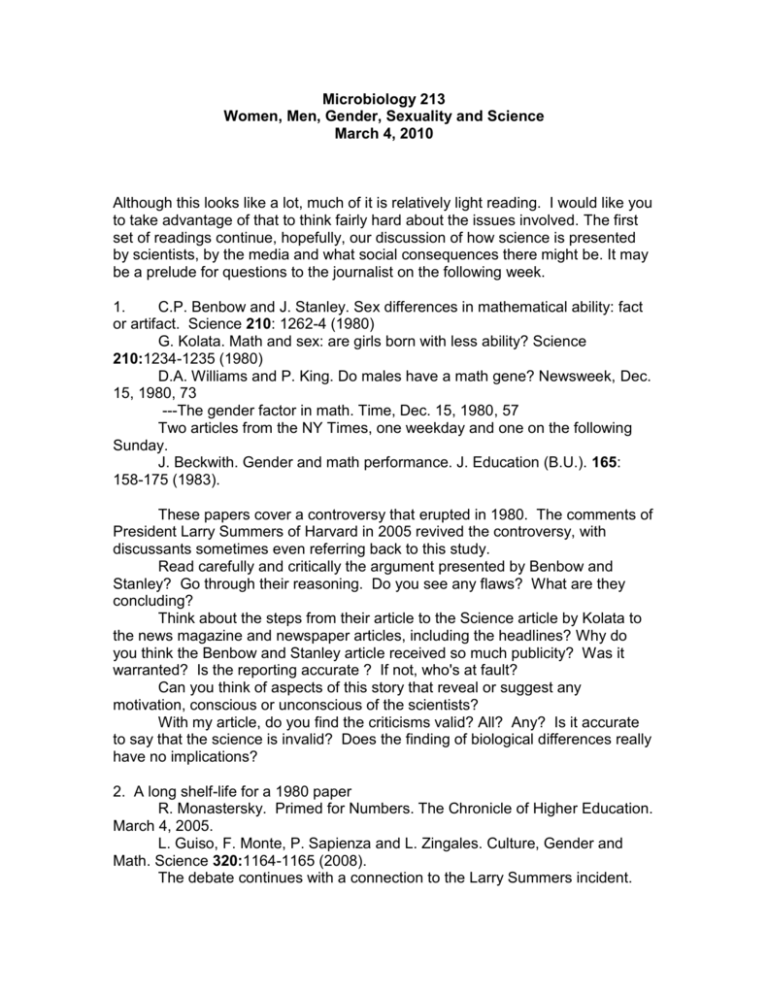
Microbiology 213
Women, Men, Gender, Sexuality and Science
March 4, 2010
Although this looks like a lot, much of it is relatively light reading. I would like you
to take advantage of that to think fairly hard about the issues involved. The first
set of readings continue, hopefully, our discussion of how science is presented
by scientists, by the media and what social consequences there might be. It may
be a prelude for questions to the journalist on the following week.
1.
C.P. Benbow and J. Stanley. Sex differences in mathematical ability: fact
or artifact. Science 210: 1262-4 (1980)
G. Kolata. Math and sex: are girls born with less ability? Science
210:1234-1235 (1980)
D.A. Williams and P. King. Do males have a math gene? Newsweek, Dec.
15, 1980, 73
---The gender factor in math. Time, Dec. 15, 1980, 57
Two articles from the NY Times, one weekday and one on the following
Sunday.
J. Beckwith. Gender and math performance. J. Education (B.U.). 165:
158-175 (1983).
These papers cover a controversy that erupted in 1980. The comments of
President Larry Summers of Harvard in 2005 revived the controversy, with
discussants sometimes even referring back to this study.
Read carefully and critically the argument presented by Benbow and
Stanley? Go through their reasoning. Do you see any flaws? What are they
concluding?
Think about the steps from their article to the Science article by Kolata to
the news magazine and newspaper articles, including the headlines? Why do
you think the Benbow and Stanley article received so much publicity? Was it
warranted? Is the reporting accurate ? If not, who's at fault?
Can you think of aspects of this story that reveal or suggest any
motivation, conscious or unconscious of the scientists?
With my article, do you find the criticisms valid? All? Any? Is it accurate
to say that the science is invalid? Does the finding of biological differences really
have no implications?
2. A long shelf-life for a 1980 paper
R. Monastersky. Primed for Numbers. The Chronicle of Higher Education.
March 4, 2005.
L. Guiso, F. Monte, P. Sapienza and L. Zingales. Culture, Gender and
Math. Science 320:1164-1165 (2008).
The debate continues with a connection to the Larry Summers incident.
But how do these readings this affect your view of the 1980 paper? Does it raise
any questions about their assumptions?
Do you think that any of the consequences of the publicity for the original
study are of concern? If so, how might things have proceeded differently,
starting perhaps with the researchers?
Professor Alan Dershowitz at Harvard Law School, in response to the
recent debates, has stated that he was going to be teching a course called
“Taboo” that would discuss the science of sex differences (presumably among
other things). Should the science be Taboo? Is that what the critics are saying?
Should any science be Taboo?
3.
S. Blaffer Hrdy. The human element in the study of human nature. Reed
Alumni Bulletin. 1983.
J. Knight. Sexual stereotypes. Nature 415:254-256 (2002).
The Hrdy paper presents an argument about how the ground rules of a
science change because of external social forces. Does this case seem relevant
to our own science or peculiar to a science that treats an issue related to human
behavior? Blaffer Hrdy is a primatologist/sociobiologist who clearly recognizes
the social influences on science, including her own.
Obviously the debate continues. Does Knight’s article seem neutral,
biased. etc?
How much do you think we can rely on animal (e.g. primate) studies to
inform us about human behavior?
4.
B.S. Mustanski et al. A genomewide scan of male sexual orientation.
Hum. Genet. 116:272-278 (2005).
A. Fausto-Sterling. Frameworks of Desire. Daedalus, Spring 2007 47-57.
E. Marshall. Sex on the Brain. Science 257:620-621 (1992).
D. Hamer and M. Rosbash. Genetics and Proposition 8: Human sexual
orientation has deep biological roots. Op-Ed piece in the LATime. Feb. 23, 2010.
The first is an article that presents a search for genes correlated with
homosexuality. Read carefully for the assumptions upon which the research is
based. Do you know what a LOD score is? What a significant LOD score is for
this kind of study? As with article like this we have read before, I don’t expect
you to have to understand every last detail of their paper.
Fausto-Sterling is criticizing the assumptions of the Mustanski paper. Do
you agree with her critique? Do you understand what she is proposing for an
alternative approach to the origins of sexuality? Is it an improvement?
The article about bias (conflict of interest) focuses on the work of Simon
LeVay who is referred to in the Mustanski paper. At that particular time, three
papers, including LeVay’s came out that presented different lines of evidence for
a biological basis for homosexuality in males. In all three cases, either the main
researchers or one of the main researcher was gay himself and each has argued
that finding a biological basis for homosexuality would improve the civil rights
situation of gays. This is why the issue of bias came up. Do you think that they
are right about the benefits of this research? (Note that this case is the opposite
of what we read about in the situation of race or women and math where biology
was being used to suggest inequalities.)
Finally, the very recent LATimes Op-Ed piece adds to the discussion of
the relevance of biology to the establishment of social norms.
Further Reading if you’re interested:
J.S. Hyde et al. Gender similarities characterize math performance.
Sicnece 321:494-495 (2008).
Authors claim that girls and boys score just as well at math.
P.A. Lawrence. Men, Women and Ghosts in Science. PLoS Biology. 4:e19
(DOI:10.371/journal.pbio.004019) (2006).
B. Barres. Does gender matter? Science 442:133-136 (2006).
This is sort of a debate between the two authors. I don’t think anyone is
truly arguing that there are no relevant biological differences between men and
women. But it is over what are the differences are, how much we know about
them, and how any knowledge about them should influence social policy.
Two books you might be interested in:
S. Blaffer Hrdy. The Woman that Never Evolved. Harvard Univ. Press. A quite
readable account of primatology and the male influences on research. Blaffer
Hrdy's sociobiological approach comes through quite strongly, and although I
disagree with aspects of that approach when applied to humans, the book is still
fascinating.
A. Fausto-Sterling. Myths of Gender: Biological Theories about Men and
Women. Basic Books. 1985. Revised in 1992, issued in paperback. A
comprehensive critique of such theories, including most of the issues discussed
in this session. Also includes Fausto-Sterling's view of an alternative science.

